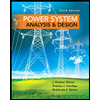
Power System Analysis and Design (MindTap Course List)
6th Edition
ISBN: 9781305632134
Author: J. Duncan Glover, Thomas Overbye, Mulukutla S. Sarma
Publisher: Cengage Learning
expand_more
expand_more
format_list_bulleted
Question
Electrical engineering, Impedance and propagation coefficient.
![For a transmission line, the characteristic impedance Zo and
the propagation coefficient y are given by
Zo =
R+jwL
G+jwC
and y = V
[[(R+ jwL)(G + jwC)]
Given that R = 250, L = 5 x 10-³H, G = 80 × 10-6 siemens, C = 0.04μF and w 2000πrad/s,
determine in polar form, Z, and y.](https://content.bartleby.com/qna-images/question/98b0f415-072a-4383-8d81-16e7b470a408/64ef5a42-9b65-47ef-975e-020e36ed8c3f/3v1bt7_thumbnail.png)
Transcribed Image Text:For a transmission line, the characteristic impedance Zo and
the propagation coefficient y are given by
Zo =
R+jwL
G+jwC
and y = V
[[(R+ jwL)(G + jwC)]
Given that R = 250, L = 5 x 10-³H, G = 80 × 10-6 siemens, C = 0.04μF and w 2000πrad/s,
determine in polar form, Z, and y.
Expert Solution
This question has been solved!
Explore an expertly crafted, step-by-step solution for a thorough understanding of key concepts.
Step by stepSolved in 2 steps with 2 images

Knowledge Booster
Similar questions
- Each phase of a transmission line is a bundle of 4 conductors that form a square with all sides equal to d=33 cm. Each conductor is stranded and has GMR = 0.5 cm. Find GMR of the bundle to be used in inductance calculations. Express your answer in cm with 2 digits after decimal pointarrow_forwarddax dta x = Az + W₂² x = 0 Woe о Ae jw tjb real imaginary Part How did they get the equations? + As Sin wot ( where did they get the cos and sn components from?) X = Acos wtarrow_forwardFind |V2| , 82, and Sgifor the system shown in Pig 1. .In the transmission system all the shunt elements are capacitors with an admittance ye-J0.01 p.u, while all the series elements are inductors with an impedance of zL = j0.1. %3D Sp2 =2.8+j1.2 SG1 V2=120° V=1.05 Z0° Figure 1arrow_forward
- el 3 An air line has a characteristic impedance of 70 Q and a phase constant of 3rad/m at 100MHZ. Calculate the inductance per unit meter and the * .capacitance per unit meter of the line C=67.2 pF/m, L=335.2 nH/m C=64.2 pF/m, L=334.2 nH/m C=65.2 pF/m, L=336.2 nH/m O C=68.2 pF/m, L=334.2 nH/m C=66.2 pF/m, L=334.2 nH/marrow_forwardFind I1, SWR, Zi, given ZL = 100 -j 50 2 with Z. = 150 N, 1= 0.25 Aarrow_forwardThis is a review question from an old exam:A 50-MHz generator with Zg =50Ω is connected to a load ZL= (50 –j 25). The time average power transferred from the generator into the load is max when Zg=ZL, where ZL is the complex conjugate of ZL. To achieve this condition without changing Zg, the effective load impedance can be modified by adding an open circuited line in series with ZL, as shown in the following figure. a) If the line’s Z0=100Ω, determine the shortest length of line (in wavelengths) necessary for satisfying the maximum power transfer condition. b) Determine for the same problem for a short circuit line in series with ZL.arrow_forward
- c) For a transmission line w/characteristic impedance Z0 = 50 W. At some point of the line, a forward wave has the voltage V+ = 10V and backward wave has the voltage V- = 4V. i) Currents of the forward wave and backward wave at that point. ii) Measured voltage and current at that point. d) A transmission line has the following properties: Length, L = 3 m. Characteristic impedance Z0 = 50 W. The load impedance ZL = 100 W. And phase constant b = p/3. Assume the forward voltage at z = 0 is VA =10ejp/4 At z = 3m, calculate: i) Forward voltage and forward current. ii) Backward voltage and backward current. iii) Measured (total) voltage and current across the loadarrow_forwardProblem 7arrow_forwardI turned the voltage value of the AC source into Vrms and got magnitude 16.97 & angle 10.Then calculated the impedance of Load A to be [ -9.28 - j23.4 ]. From that, I calculated the complex power of load B to be [ -2.42 + j6.33 ] my power factor calculation I am using inverse tan ( Q/P) , where Q i got -1.91 & P to be 5.559, which I got from my total complex power. If that helps. But I am calculating a negative power factor, so i am curious where I went wrong, Thank you!arrow_forward
- How can I find shunt capacitance?arrow_forwardThe following vectors are given : M=-10ax+4ay-8az and N=8ax+7ay-2az. Find the magnitude of 5ax+N-3Marrow_forwardIs curtent (I.) linear function a dliving freguency? given and eguation !2/=V RE + (wL- Consider this the AC version of ohm's Law 12/3VR +(WL-arrow_forward
arrow_back_ios
SEE MORE QUESTIONS
arrow_forward_ios
Recommended textbooks for you
 Power System Analysis and Design (MindTap Course ...Electrical EngineeringISBN:9781305632134Author:J. Duncan Glover, Thomas Overbye, Mulukutla S. SarmaPublisher:Cengage Learning
Power System Analysis and Design (MindTap Course ...Electrical EngineeringISBN:9781305632134Author:J. Duncan Glover, Thomas Overbye, Mulukutla S. SarmaPublisher:Cengage Learning

Power System Analysis and Design (MindTap Course ...
Electrical Engineering
ISBN:9781305632134
Author:J. Duncan Glover, Thomas Overbye, Mulukutla S. Sarma
Publisher:Cengage Learning